When research shows that roughly nine-in-ten Americans use the internet1, a business that doesn’t exist on any digital format today almost doesn’t exist to consumers. More consumers than ever start their research online, with 81% of them conducting online research before buying and 60% starting their research on a search engine.2
Digital management should be a priority for companies looking to increase brand awareness, acquire additional customers, and improve their reputation online.
Determining how to be noticed on digital mediums, and successfully market to and track the consumers who find you online, is vital to your business’ success. CallSource always advocates the importance of making data-based decisions; this is true for your online marketing attribution as well as your offline attribution.
Having a solid digital management system in place helps businesses ensure they are viewing the whole marketing journey, delivering content to their consumers in any possible way that they want it.
Digital Marketing and Web Analytics
To implement an effective digital strategy, you need to track your digital marketing and web analytics.
Web Analytics
Web analytics involves the process of the collection, measurement, and analysis of user activity on a website to understand and help achieve the intended objective of the website.
The objective is usually one or a combination of:
- Increased revenue
- Lower cost
- Improved customer service/experience
Web analytics works alongside digital marketing. Web analytics can make certain that website content and the overall website user interface (UI) and user experience (UX) are tailored to the behavior and interests of the target audience.
You can monitor your website users and optimize your business’ website to appeal to the navigational tendencies of customers, formulating, and updating your digital marketing plan of action depending on their interactions.
Digital Marketing
A lot of web analytics depend on digital marketing. Digital marketing is a term given to any form of marketing products and services through online channels. Channels are high-level categories indicating how people found a site. Put simply: where did they come from?
There are a few different channels that consumers use to find you in the digital world:
- Organic
- Traffic from users who land on your page from clicking a listed link on a search engine results page that was listed naturally – someone did not pay to get the result in high ranking.
- Paid
- Traffic from search engine results that is the result of paid advertising via Google Adwords or another paid search platform.
- Direct
- Traffic that has come to your site by either typing in your URL in their address bar or clicking on a bookmark. In general, this indicates visits where users navigate directly to the URL or the source of the visit is unknown.
- Referral
- Traffic that has come from another site to your site, not relating to traffic coming from a search engine.
- Examples might include Facebook, Twitter, LinkedIn, or any site/domain not owned by you.
SEM vs. SEO
A lot of digital marketing and web analytics depend on search engine marketing (SEM) and search engine optimization (SEO).
An easy way to remember these two differences is SEM is paid while SEO is not.
SEM is a form of internet marketing that increases a site’s visibility through paid search engine results and advertising; it includes things such as paid ads and 3rd party websites.
SEM results are short-lived, quick results. Usually, you will pay per each result:
- Cost per click (CPC)
- Cost per lead (CPL)
- Cost per acquisition (CPA)
SEO is an organic way of increasing the number of website visitors by getting your site to appear high in search ranking results.
SEO results are long-lasting; you must be vigilant with SEO to stay ahead of the trends. A few examples of ways to optimize your page for SEO are:
- Publish relevant content
- Improve page loading speed
- Optimize images
- Remove broken links
- And much more
SEM and SEO are much more in-depth topics, but they both have a high impact on digital marketing and website optimization plans.
Advertising on Digital
In addition to your static advertising campaigns, it is important to have digital advertising for your business, no matter what industry you are in. In fact, research shows that digital channels will overtake traditional mediums by 2021.3
Hopefully, you are already advertising on digital platforms, but whether or not you are, you may need some assistance in deciding exactly where to advertise. While it is vital that you do some research on what mediums your “ideal customers” spend time on, there are still many places to choose from, since there is a slew of options on the internet.
Although this isn’t a full, comprehensive list, below are some of the most popular places for businesses to place digital advertisements to get you started.
PPC
Pay-per-click advertising, also known as PPC, is a form of digital advertising that prompts advertisers to bid to have their ads displayed on popular websites to generate traffic.
Every time that an ad is clicked, the advertiser must pay a fee. PPC basically allows you to “buy” traffic for your website, web pages, or wherever you direct users to when they click on your ad. One of the most popular forms of PPC advertising is paid search advertising, also known as search engine advertising. This kind of digital advertising allows advertisers to bid for top ad placement on a search results page.
Google Adwords
Google Adwords reign so supreme in the world of PPC advertising platforms that Google Ads are now almost known as being synonymous with PPC.
With Google Ads, instead of bidding to have your ads displayed on popular websites, you must bid on certain keywords to have your ads displayed at the top of Google’s search results – a hard spot to earn organically by getting to the top of page one search results.
Bing
Second to Google is Bing, another popular search engine that has a 34% share of the U.S. search market.4
Bing is a cheaper alternative to Google advertising since it is not as dominant in the market, yet still relevant. Bing partners with Yahoo for their ad network, which means your reach is expanded when advertising with Bing.
Bing lets you control campaigns at a more granular level than Yahoo and has more targeting options as well.
It is also relevant to note that voice-search is becoming increasingly popular, and power-house Amazon’s Alexa product gains all of its search results from Bing. Keep this in mind, as it may mean that Bing will become more prominent in the coming years.
Display Ads
Display advertising allows the advertiser to have ads placed on relevant third-party sites in the form of a banner, image, or text ad. They can be placed anywhere on the page – but must be optimized to target audiences, and should direct to a specific landing page as well.
Email Marketing
Most lead generation strategies are focused around collecting a form of contact – usually an email address – from a potential lead. Email marketing is said to be one of the most effective forms of digital advertising, with an ROI upwards of 40%, according to reports.5
Email marketing allows brands to talk to their prospects more personally on a consistent, ongoing basis. If a consumer is committing to receive your emails, then they have a higher probability of engaging with your brand.
With the potential for higher conversions than most other forms of digital advertising, email marketing is a must for any smart digital marketer.
Social Media
Advertising on social media keeps increasing since social media usage stays on the rise.
There are many social media platforms to advertise on. Make sure you discover where your “ideal customers” spend their time and target those social media channels to test out your advertising. Below are a few of the most popular platforms.
Facebook
Not surprisingly, Facebook dominates the social media world. As of 2018, almost 70% of U.S. adults are Facebook users, according to Pew Internet Research.6
YouTube
YouTube is also a top contender in social media channels, with roughly three-quarters of U.S. adults and 94% of 18-24-year-olds using the video-sharing site.6
Others
Below are some of the other most popular social media platforms that you should pay attention to, and research more to see if it is worth the effort for your business to advertise on. Keep in mind there are more than this list contains – make sure you know which social media platforms are most relevant to your business, your consumers, and your industry.
| Snapchat | ||
Video
Research shows that 25% of US digital ad spend went to video in 2018.5 The most common video advertising can be found on video channels such as YouTube, but keep in mind that social-media leader Facebook also captured almost one-quarter of all video ad spend in 2018.
Video isn’t only becoming more popular for digital ads – but a more popular way of consuming content overall, so you want to make sure that you are present in more types of ads than just static text or photo content.
Where to advertise
No matter where you choose to advertise, make sure your decisions are based on research and tested to see what your most viable digital advertising platforms really are. You will need to correctly attribute each platform – which you can find more details on later in this article. If you are a local business looking for digital marketing strategies check out our podcast episode on this topic here.
Tracking Attribution with Cookies vs. Non-Cookies
Cookies are not altogether dead as many would have suggested back in 2014. The demand for accurate attribution continues to rise.
As users continue to utilize multiple devices from various locations throughout the day, the largest data analytics tracking, companies are continuing to develop viable non-cookie options. The bottom line is—if you want precision tracking users online, you will need a non-cookie based method. Google, Microsoft, Facebook, LinkedIn, or Twitter don’t provide them.
What are tracking cookies?
At the most basic level, cookies are labels. Cookies label both the web pages when they load and the user who visited, with their demographic information. The labels describe useful information about the user and the web pages they visit. Every cookie should be unique to every user and contain an ID that the platform uses to keep track.
Unlike a typical ID, the cookie does not contain directly identifiable information about the user. Privacy conspirators rejoice because cookies are inherently incomplete at identifying people behind the user. Though tracking with cookies is still a widely used practice, there are several flaws of cookie tracking.
The flaws in cookie-based user tracking
As mentioned above, cookies use the label of user to define someone visiting a web page. But what exactly is a user, and why are they flawed?
- Users do not represent actual people; they are only a count of unique ID’s.
- Users are not shared by different browsers, devices, or locations.
- Users are easily deleted and often deleted by the actual people that they supposedly represent.
- Users are only unique to a specific time period. After that, they are reset.
- Users counts are not perfectly precise and are often adjusted from the actual numbers by an unknown amount.
- Having sampled users only gives a distant snapshot, not precise data, when working with “Custom Segments” or adding second dimensions to the data.
How do these flaws affect your analytics data?
Marketing is made more effective in every circumstance when the information communicated is personalized to the end user. Cookies help to facilitate this personalization by storing information that will help to reduce spam and redundancy, and increase relevance.
The experience of users is greatly affected by cookies. Cookie data helps websites to remember a user’s preferences on websites, ensure that websites are handling data securely, and switch information in advertisements to make them more relevant to the user.
However, the flaws in cookies have a direct impact on your marketing. Whenever you calculate any metrics that rely upon your website counts, cookies will deliver data filled with artifacts and errors. Although they cause a lot of controversy in privacy, it is the business marketer who wants to make sure that they get what they pay for out of their web traffic, such as:
- Exactly how much traffic you are getting from channels you pay for.
- The quality of the traffic you are getting from channels you pay for.
- Confidence that the traffic you are receiving is filled with real people.
These three demands do not seem that hard to answer, but with cookie-based tracking, you are taking an educated guess at the precision of your data. Statistics tell us that the only way to increase our confidence with the precision of our data is to increase the size of the sampled group so that it more closely matches the population it represents. Look at the following graph for an example:
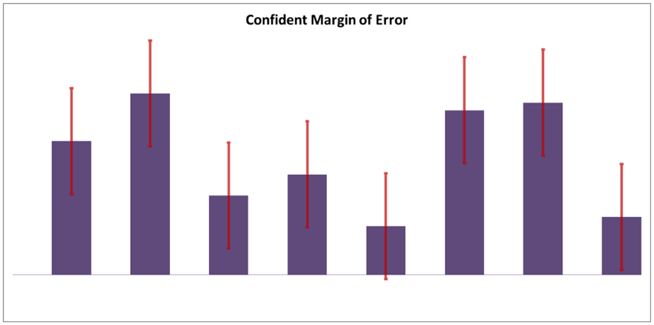
In this graph, the columns represent counts of data, and the lines represent the standard deviation for these averages based on a 99% confidence level.
As you can see, the data is accurate to a degree of error that falls within the lines; the errors are very large for this small data set. This oversimplified example shows how data is skewed in small numbers and how large the chance is for error.
What is a large enough sample for accurate data?
The only way to diminish the flaws of user traffic is to significantly increase the data size. If you have web traffic in the hundreds of thousands a day, is that enough to minimize the flaws and have more precise results?
Just like their confectionary counterpart, with cookies, your data is as good as what you put in. If you want 90% precision in your data, then you should expect to rely on results that are 90% accurate. Be as demanding as your organization needs. This is a decision that has to be made at the beginning.
If you want chocolate chip, you need to put chocolate chips into the dough. If you want peanut butter, you need to put that into the dough. The same goes for measuring web traffic, leads, phone calls, bounces, visitors, sessions, and ultimately – attribution.
The cookie-less world of tracking
Companies such as Microsoft, Facebook, Twitter, Google, and LinkedIn (to only name a few tracking platforms) are slowly shifting away from cookies. They are completely aware of the flaws outlined and yet have not leaped into the cookie-less world.
Why stick with cookie tracking?
Cookies are not easily replaced. Technology has come a long way in the decades since the inception of the internet, and there is still a lot of valuable information that can make use of cookies. Locally shared and flash-based versions of cookies help applications to load, servers log information into cookies, and developers use cookies to second-hand ensure that everything is working.
The transition means changing to a new system and having to force marketers to adopt. Privacy laws are still barely catching up, and entrepreneurs have to cope with those privacy entry barriers. The services paving the way are making use of cookie-less tracking by showing off all the innovative techniques for personalizing marketing.
The future is a cookie-less world
As long as organizations are creating cookie-less tracking systems that allow for protecting privacy, they will be steps ahead of even the largest platforms in the world. The innovations that are available to marketers who are released from the flaws of cookie tracking are numerous.
Multi-Channel Digital Attribution Models
Understanding the complete customer journey means accurately attributing the correct marketing channels (advertising paid and non-paid sources) responsible for turning a consumer into a customer. Measuring true ROI and the impact of your marketing efforts depends on the attribution model that you use.
But what are some of the most common digital attribution models, and how can you determine which fits your business’ needs? Below are five of the most commonly used multi-channel digital attribution models.
Last Click/Final Click Attribution
Last Click attribution attributes – you guessed it – the final channel’s click-through to the source of lead generation. Assuming several channels had touches to the consumer along their complete journey, Last Click will attribute the channel that they touched last to receive the credit in converting that lead.
Example #1 – A consumer sees an advertisement on television, and then sees that advertisement again later on YouTube. Later, they get an email promoting the advertisement, and finally, they decide to Google the company before buying. In this example, organic search gets the credit and the attribution for converting that person into a lead. Google is the last action the consumer took.
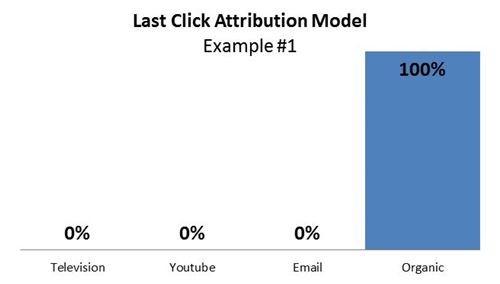
| PROS | CONS |
| Most reliable for cookie-based tracking. | Negates contribution of prior channels. |
| Simplest to use; usually the default model. | Doesn’t usually reflect marketing efforts. |
First Click Attribution
First Click attribution is the reverse of Last Click. The first channel that brought someone into all of the other channels is given the credit in lead generation. Assuming that there were several channels that had touches to the consumer along their complete journey, First Click gives attribution value to the very first channel that you have tracking information on for.
Because of the unreliability in tracking attribution, most models prefer Last Click, since First Click attribution is the most susceptible to unreliable tracking. For example, if someone deletes their cookies from a cookie-based tracking system, then you get unreliable first clicks since their first channel will be reassigned after their cookies were purged.
Example #2 – Imagine again that a consumer sees an advertisement first on television, then watches the advertisement on YouTube. They then receive an email promotion for that advertisement, and finally they search and convert to a lead from organic search before buying. In this example, the very first click or channel, namely television, will get the credit for the attribution.
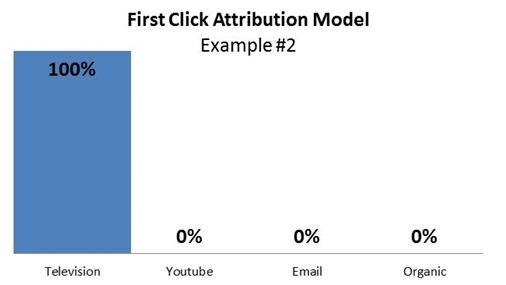
| PROS | CONS |
| Emphasizes awareness strategies. | Most unreliable cookie-based tracking model. |
| Used in brand awareness and political campaigns. | Entry channels are over-weighted. |
Linear Attribution
Linear Attribution modeling was statisticians’ go-to before exploring years of extended data. In statistics, it is a rule of thumb to first assign all weights a consistent value before attempting to individualize the weighting of every element.
The purpose of assigning equal value along the chain is that it may be too complex, and you may not actually know enough to weigh any specific channel greater value than another. This model excels at awareness and recognition strategies but does not help you do much else. Linear Attribution also has the flaw that if something did have a greater impact on the whole marketing spectrum, you would not be able to identify it correctly.
Example #3 – Assuming the same story as the examples prior, each click along the complete customer journey is assigned equal value as long as the consumer eventually converts.
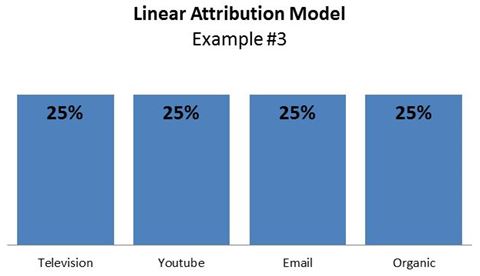
| PROS | CONS |
| Simplest (think statistician). | Nothing is given uneven weights. |
| Does not emphasize any particular strategy. | Cookie-cutter marketing strategies. |
Time Decay Attribution
Time Decay attribution can be a confusing model, as you need to know at which point the greater credit is assigned to a channel. In Time Decay modeling, the channels at the end of the consumer journey receive the most credit, and the channels at the beginning receive the least. The channel at 50% of the consumer journey would, therefore, receive 50% of the weight.
Time Decay is helpful if you see a lot of your channel traffic from season and clustered events. You can weigh conversions nearest to the channels that led to a conversion more and give less credit to channels that contributed in a time period that may not have contributed to the consumer’s final decision to convert.
Example #4 – Assuming the same story as the examples prior, each click along the complete customer journey is assigned increasing value as long as the consumer eventually converts. Another way to describe it is that each click’s value decays over time as more channels and clicks are added.
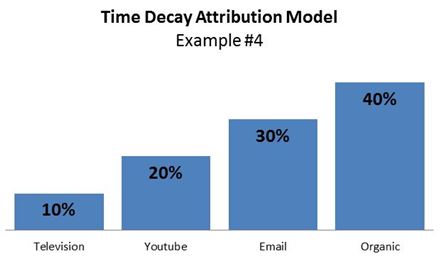
| PROS | CONS |
| Gives credit to clusters of clicks. | Assumes that prior clicks are worthless. |
| Helpful if you have most of the market share already. | Favors a bottom of funnel-centric strategy. |
U-Shaped/Position Based Attribution
Position Based attribution modeling is one of the models that actually favors a certain type of marketing strategy. Position Based attribution favors straight lead generation as it gives credit to the beginning channel that brought someone in and the final channel that converted. This is why it has a U shape, as seen in the example.
Position Based tracking does suffer from cookie-based tracking, as does any model that relies at all upon reliability. However, this model does have strengths in giving credit to marketing efforts at the ends, where the big impact actions happen. Giving credit to the end and beginning rewards the acquisition channels of marketing; which is why it lends itself to lead generation strategies.
Example #5 – Assuming the same story as the examples prior, each click along the complete customer journey is assigned a value, but when the conversion happens, the first click and the last click are given much more credit.
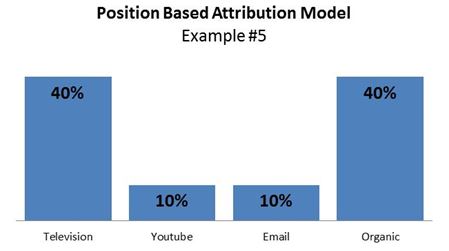
| PROS | CONS |
| Focuses on two important clicks. | Doesn’t help you build complex strategies. |
| Leans towards lead generation strategies. | Ignores values of relationship building. |
Which attribution model to use?
In the end, you will need to decide what model best reflects how your business does marketing and match the model to the type of improvements you want to focus on.
Keep in mind that there are marketers that swear by each and every model, so do your research to determine which model best suits your business.
Marrying Online and Offline Attribution: Dynamic Number Insertion
One of the ways to combine some of your offline and online marketing (O2O) is with dynamic number insertion (DNI), which measures the impact that calls have on your digital marketing.
DNI enables businesses to attribute phone calls generated from PPC ads, SEO campaigns, retargeted ads, and more to measure success for each digital marketing channel.
How does DNI work?
When a lead comes to your website, DNI will display a unique phone number to that user based on a unique user or source.
DNI uses a pool of local or toll-free numbers in the background based on your website to ensure that each user (or source) is assigned its own specific phone number to track through from digital to offline conversion.
DNI Set Up & Use
- Determine your highest daily number of concurrent users on your website. This will be used to determine your dynamic phone number pool.
- Install a one-line snippet of JavaScript on your website.
- Assign the source code(s) for where your DNI numbers will be placed on your website.
- When a user visits your website, DNI’s JavaScript will detect the user and/or source they came from and swap out the phone number automatically for that unique user or source.
- When the user calls the dynamic phone number, you can tie back online actions made before the call to users.
How does CallSource’s DNI solution differ?
CallSource’s DNI gets more granular and is more robust than most solutions. This is because our DNI does not use cookies, allowing the data delivered to be highly accurate and person-specific instead of “user” specific.
Once the page loads with the script, users will be tracked in two ways:
- ID (Unique Identifier) as a unique person without using cookies
- Sessions. These include:
- Time/Dimensions
- Activities
- Properties (moving from different owned domains)
Information is stored about this unique user that allows not only cross-domain tracking but actual cross-device tracking as well. Instead of relying on cookies for a user, CallSource’s DNI tracks a specific person no matter the device they are using at that moment: desktop, phone, tablet, etc. No other DNI solution can do this.
Rather than tracking groups of users coming to your site, CallSource’s DNI allows you to accurately track real people – so you aren’t missing any of your marketing data.
For online to offline attribution, many actions are tracked:
- Chats
- Emails
- Calls
- Form Fills
- Texts
Additionally, CallSource has dynamic number pool size adjustment included in our DNI – meaning that you don’t have to rely on the specific number of dynamic numbers that you first allotted with your DNI solution. Why is this important?
If you end up having more concurrent visitors on your site than originally allotted for, CallSource’s DNI will automatically add more numbers as needed, where a regular DNI solution would end up having to assign the same number to multiple users – not an ideal situation.
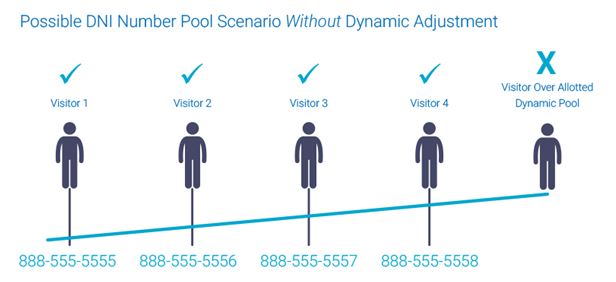
How to get started with DNI
After determining how specific your DNI needs are, do some research on which DNI solutions are best suited to your business. DNI is a must for any marketer that relies on the internet, as well as the phone, to acquire leads and make sales.
Choosing the Right Vendor for Your Digital Needs
First, what are you trying to accomplish, or what do you need assistance with regarding your digital management? Some digital management vendors may have too little or too much available for you to utilize. It is important that you know your goals and needs before choosing the right company.
Once you determine the right digital management solution for your company, be sure to read the following before implementation.
Define specific goals for your digital management system
Create specific SMART (Specific, Measurable, Achievable, Relevant & Time-bound) Goals you want to achieve with your digital management system.
Make a timeline for yourself for achieving your goals.
If you don’t know where to start—answer why you want to purchase and implement digital management and work backward. Discuss your goals with the vendors you are deciding between and validate your timeline with them. If they don’t take an interest in your goals or your business before they make the sale, it is indicative of the support you will receive later in the relationship. If your vendor isn’t helping you in making the right decisions, they’re probably not right for you.
Team buy-in and excitement
Remove ambiguity from your team. Explain to your colleagues and manager(s) how and why you are implementing digital management.
Create clear expectations of responsibilities and accountability with regards to the reports and data each person will use and how to create a system for a feedback loop to find out what is working and what is not. Remember, negative feedback isn’t bad as long as it is constructive.
Look at online reviews
Before purchasing your new digital management system, look at their online reviews and testimonials. Some great review platforms to read reviews for digital management solutions are G2 Crowd, Google, and Capterra.
Consult industry groups and talk to peers who may use digital management platforms and find out first-hand what they do or don’t like about who they use. (Tip: Grab our ultimate guide to reputation management here).
CallSource’s Digital Management Platform
Although this guide is to help you learn about digital management and how to utilize it for your organization, CallSource would be remiss without mentioning our own digital attribution solution, EveryLead, powered by AutoID.
EveryLead is a cookie-less marketing attribution platform which tracks and reports on all offline and digital advertisements, plus gives analysis of prospect and conversion-to-appointment ratios. It is the only platform of its kind that shows calls, texts, chats, and web leads in a single, real-time dashboard.
EveryLead enhances Google Analytics to refine the consumer’s online interactions, give more specific reporting, add a level of precision to lead acquisition, and update Google Analytics goals.
Together with Google Analytics data, they provide tremendous value:
- Proprietary Tracking
- Website Compatible
- Central Unbiased Database
- Custom Goal Tracking
- PPI Privacy Compliant
- Proprietary Audiences
- Near Real-Time Data
- Consolidated Reporting
- Competitive Insights
- Utilizes UTM Tracking
- Shareable Reports
- Exports into Excel
Conclusion
Choosing a company to help with your digital management needs will take some research. Evaluate all your options; make sure the company you are going to choose can support your business goals and provide the level of support that you want.
We hope that this guide has answered your questions about digital management and how digital management will help your business’ marketing and lead generation needs.
If you have further questions regarding digital management or just are interested in learning more, subscribe to our blog or schedule a demo with one of our specialists for more insights and solutions.
We are the experts in call tracking, call management, performance management, review management, and digital management. Contact us today to learn how we can help with your digital management needs.
References
- http://www.pewinternet.org/fact-sheet/internet-broadband/
- https://www.madebytribe.com/the-online-buyers-journey-infographic/
- https://www.emarketer.com/content/global-ad-spending
- https://advertise.bingads.microsoft.com/en-us
- https://www.campaignmonitor.com/blog/email-marketing/2016/01/70-email-marketing-stats-you-need-to-know/
- http://www.pewinternet.org/2018/03/01/social-media-use-in-2018/
- https://www.emarketer.com/content/video-swells-to-25-of-us-digital-ad-spending

